Catholic
Piety
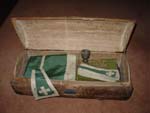 Stonyhurst
College
guards a remarkable collection of objects of piety cherished by Catholics
during penal times. No aspect of piety was more crucial that the Sacrament
of the Eucharist. St.
Edmund Arrowsmith (1585-1628) was educated at the seminary in Douai
and ordained in Arras (France). At this time anyone wishing to be educated
as a Catholic had to seek schooling outside England. Arrowsmith worked
clandestinely as a priest in Lancashire from 1613 to 1624 and in 1624
entered Society
of Jesus. He was arrested, confined in Lancashire Castle, and hanged
August 28, 1628.
Stonyhurst
College
guards a remarkable collection of objects of piety cherished by Catholics
during penal times. No aspect of piety was more crucial that the Sacrament
of the Eucharist. St.
Edmund Arrowsmith (1585-1628) was educated at the seminary in Douai
and ordained in Arras (France). At this time anyone wishing to be educated
as a Catholic had to seek schooling outside England. Arrowsmith worked
clandestinely as a priest in Lancashire from 1613 to 1624 and in 1624
entered Society
of Jesus. He was arrested, confined in Lancashire Castle, and hanged
August 28, 1628.
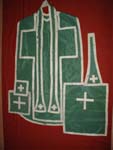 He
traveled with his mass vestments, altar frontal, and chalice veil, then
required for the valid celebration of the Eucharist. His peddler's trunk
of wood covered with horsehair with its vestments stash was walled up
in a Lancashire cottage and only discovered in the 1880s and the contents
labeled
He
traveled with his mass vestments, altar frontal, and chalice veil, then
required for the valid celebration of the Eucharist. His peddler's trunk
of wood covered with horsehair with its vestments stash was walled up
in a Lancashire cottage and only discovered in the 1880s and the contents
labeled 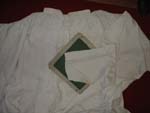 as
"fancy dress". When discovered it showed a lady's hat covering
the vestments, obviously a ruse to distract attention for the illegal
Catholic ritual garments. The trunk contained several chasubles,
the outer vestment of the priest, with matching maniples,
the small piece of fabric over the arm, and stoles, a long piece of
fabric worn around the neck. The garments are placed over the alb,
a long white garment that signifies purity.
as
"fancy dress". When discovered it showed a lady's hat covering
the vestments, obviously a ruse to distract attention for the illegal
Catholic ritual garments. The trunk contained several chasubles,
the outer vestment of the priest, with matching maniples,
the small piece of fabric over the arm, and stoles, a long piece of
fabric worn around the neck. The garments are placed over the alb,
a long white garment that signifies purity.
 Arrowsmith
also had a rosary bracelet, thus allowing less conspicuous prayer aides
than rosary beads. The rosary
is a recitation of prayers aided by the use of a string of beads placed
as designated intervals encouraging the meditate on one of the subjects
called either the Joyful, Sorrowful, or Glorious Mysteries taken from
the Life of Christ and the Virgin Mary.
Arrowsmith
also had a rosary bracelet, thus allowing less conspicuous prayer aides
than rosary beads. The rosary
is a recitation of prayers aided by the use of a string of beads placed
as designated intervals encouraging the meditate on one of the subjects
called either the Joyful, Sorrowful, or Glorious Mysteries taken from
the Life of Christ and the Virgin Mary.
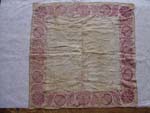 A
corporal, dating
about 1590-1600 is embroidered with the letters IHS and pomegranates,
symbolic of eternal life. A corporal is the cloth laid on the altar
over which the priest places the host and chalice of consecration. The
IHS are the
first three letters of the name of Jesus in Greek. In the absence of
a priest to celebrate the Eucharist, the corporal that had touched the
consecrated host, the sacramental body of Christ, was seen as a relic.
The meticulous mending of the fabric, in detail, below left, is an indication
of its preciousness.
A
corporal, dating
about 1590-1600 is embroidered with the letters IHS and pomegranates,
symbolic of eternal life. A corporal is the cloth laid on the altar
over which the priest places the host and chalice of consecration. The
IHS are the
first three letters of the name of Jesus in Greek. In the absence of
a priest to celebrate the Eucharist, the corporal that had touched the
consecrated host, the sacramental body of Christ, was seen as a relic.
The meticulous mending of the fabric, in detail, below left, is an indication
of its preciousness.
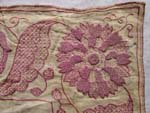 Lay
Catholics might carry a pocket devotional object. Thomas Lusher, 1593-94
a pupil at St.
Omers, the English-speaking Jesuit school in France carved a shrine
2 1/2 inches in height. When open it allowed meditation on Christ's
suffering and death by showing Instruments of the
Lay
Catholics might carry a pocket devotional object. Thomas Lusher, 1593-94
a pupil at St.
Omers, the English-speaking Jesuit school in France carved a shrine
2 1/2 inches in height. When open it allowed meditation on Christ's
suffering and death by showing Instruments of the 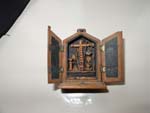 Passion
(ladder, hammer, nails, crown of thorns, etc. ) On the base is incised
Ora pro Tho Lusher qui fecit 1623 (pray for Thomas Lusher who made this
in 1623). See English
15th-century manuscript with the Instruments of the Passion from
the Huntington Library.
Passion
(ladder, hammer, nails, crown of thorns, etc. ) On the base is incised
Ora pro Tho Lusher qui fecit 1623 (pray for Thomas Lusher who made this
in 1623). See English
15th-century manuscript with the Instruments of the Passion from
the Huntington Library.
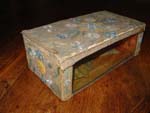 With
the production of martyrs, Catholic tradition encouraged the veneration
of their relics.
A hand-made wooden box with silk covering embroidered with silk thread
and glass beads may date from the 1590s. Its treasure is an arm bone
presumably of one of four priests, Edmund Duke, Richard Hill, John Hog
and Richard Holliday who were together at Durham in 1590. In pearls
the inscription reads: CUSTODIT DNS OIA OSSA FORUM PS 33:21 This is
probably a reference to Psalm 34 (33): 20 He keeps all his bones; not
one of them is broken.
With
the production of martyrs, Catholic tradition encouraged the veneration
of their relics.
A hand-made wooden box with silk covering embroidered with silk thread
and glass beads may date from the 1590s. Its treasure is an arm bone
presumably of one of four priests, Edmund Duke, Richard Hill, John Hog
and Richard Holliday who were together at Durham in 1590. In pearls
the inscription reads: CUSTODIT DNS OIA OSSA FORUM PS 33:21 This is
probably a reference to Psalm 34 (33): 20 He keeps all his bones; not
one of them is broken.
A series of liturgical vessels brought with the Jesuit missions to Maryland include a chalice secretly produced in Elizabethan times after the pre-reformation forbidden models. It was used to celebrate Mass in Lancaster plantation in Rock Point, Charles County, Maryland in the early 18th century.
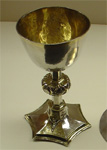
 Catholics
still produced ritual objects under penal times. Dating between 1640 and 1660, a series of eighteen Jesuit missioners in East Anglia were provided chalices by William, the fourth Lord Petre (1627-1683). One of these chalices was taken to the Maryland colony where Jesuits were almost the exclusive priestly representative. The exhibition will contain not only the Georgetown Petre Chalice, but another from this series now at Stonyhurst College . The heritage of Jesuit history was the subject of a major exhibition by the Special Collections Division to honor Georgetown University 's celebration of the bicentenary of the American Revolution in 1976. A chalice, silver with
gilt interior of the cup, on the left, was made in 1684. It is inscribed
with the donor's name, Elizabeth Rookwood but the maker stayed anonymous.
(Martin D'Arcy Gallery)
Catholics
still produced ritual objects under penal times. Dating between 1640 and 1660, a series of eighteen Jesuit missioners in East Anglia were provided chalices by William, the fourth Lord Petre (1627-1683). One of these chalices was taken to the Maryland colony where Jesuits were almost the exclusive priestly representative. The exhibition will contain not only the Georgetown Petre Chalice, but another from this series now at Stonyhurst College . The heritage of Jesuit history was the subject of a major exhibition by the Special Collections Division to honor Georgetown University 's celebration of the bicentenary of the American Revolution in 1976. A chalice, silver with
gilt interior of the cup, on the left, was made in 1684. It is inscribed
with the donor's name, Elizabeth Rookwood but the maker stayed anonymous.
(Martin D'Arcy Gallery)
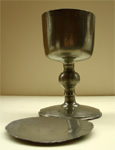
For expedience, base metals rather than the traditional silver and silver gilt were sometimes pressed into service. A pewter chalice and paten of presumed Maryland manufacture long associated with the missions date to about 1650-1700. They are now in the Georgetown University Special Collections.
Embroidery
continued to be an expression of piety. Helena Wintour in 1655 worked
a highly elaborated set of red and white vestments, including chasuble,
chalice veil, and burse to hold the corporal
Wintour's father and uncle were executed as part of the Gunpowder
Plot to assassinate James I, a supporter of Calvinists and build
a more Catholic-friendly monarchy.
An unusual form of prayer book is the Middle English poem on the Passion
called an Arma
Christi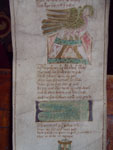 scroll.
scroll. 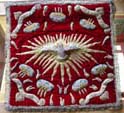 Meditations in the Passion are written on vellum and decorated
with images of Christ laid out on the grave and the instruments of the
Passion that were a part of his suffering, such as the nailsthat pierced
his hands and feet, and the spear that pieced his side are illustrated
in a series. There are over 15 surviving examples the poem which was
most probably made for public use, to be displayed in churches to stimulate
the devotion of the unlettered parishioner.
Meditations in the Passion are written on vellum and decorated
with images of Christ laid out on the grave and the instruments of the
Passion that were a part of his suffering, such as the nailsthat pierced
his hands and feet, and the spear that pieced his side are illustrated
in a series. There are over 15 surviving examples the poem which was
most probably made for public use, to be displayed in churches to stimulate
the devotion of the unlettered parishioner.
